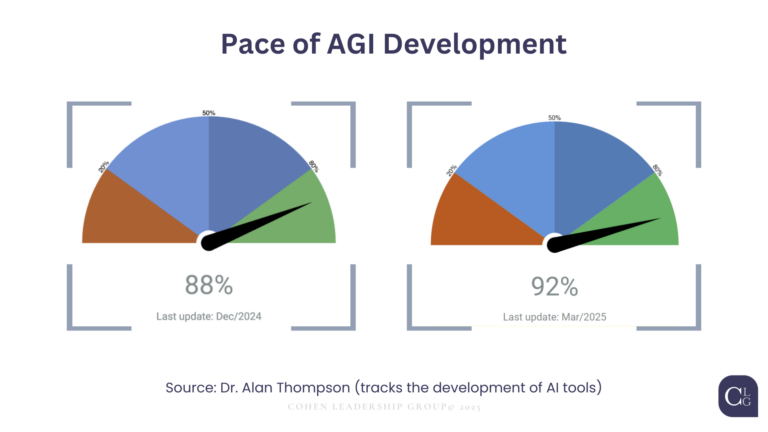
AI Won’t Wait: How Mid-Market Executives
Can Catch Up and Lead Forward
By Lauren Cohen, CEO Cohen Leadership Group
Earlier this month, our firm hosted a closed-door executive forum with leaders from across industries exploring one of the most pressing challenges facing today’s leaders: How do we lead strategically through AI, uncertainty, and constant disruption without losing people?
The forum struck a chord. The dialogue was so rich and relevant that attendees asked for more time—so yes, round two is coming (read all the way to the bottom if you want in!). Whether you missed the forum or want a recap, here’s what stood out.
Where Mid-Market Organizations Are Now: A Snapshot
What we heard confirmed a pattern: interest in AI adoption is high, but strategy is lagging.
1. Most mid-market organizations don’t yet have a clear, enterprise-wide AI strategy.
“We have one person in operations who’s figured out how to use ChatGPT and now everyone’s asking them questions—but there’s no broader plan.”
Adoption tends to be ad-hoc—led by power users inside departments, not driven by big-picture vision or cross-functional coordination.
2. No one’s quite sure who owns AI.
“Is this an IT initiative? A CEO priority? Or does every department lead their own thing?”
Without clear ownership and cross-functional collaboration, organizations risk fragmented progress and missed opportunities.
3. Leaders know their teams are experiencing fear and mistrust—but aren’t sure how to address it.
“There’s excitement, sure—but a lot of fear too. People are quietly wondering if their job is going to disappear.”
Without creating space to acknowledge these fears, it’s hard to shift teams from anxiety to opportunity and innovation.
4. Executives feel pressure to act—but time and clarity are in short supply.
Most leaders want to plan—but day-to-day demands leave little room to think strategically.
📊 What the Data Says: The Case for Urgency on AI
To frame the conversation, we shared a few data points that put the pace of change into perspective:
- 30% of current work hours could be automated by 2030 (McKinsey)
→ Especially in roles involving data synthesis, repetitive tasks, and operational workflows.
- 92% of Fortune 500 companies had adopted OpenAI tools as of late 2024
→ Whether through pilots, integrations, or full-scale deployment, AI is now a strategic priority—not a side experiment in the world’s largest organizations.
- Progress toward Artificial General Intelligence (AGI) is accelerating rapidly
→ According to AI researcher Dr. Alan Thompson:
- In Dec 2023 AGI was 62% developed
- By Dec 2024 AGI was 88% developed
- As of March 2025 AGI was 92% development
→Note: As Dr. Thompson explains, when AGI is 100% developed, it will be as effective at processing information as the average human.
→ That kind of velocity changes the timeline—and the leadership mindset required to navigate it.

Organizations Don’t Need All the Answers to Lead AI
Adoption—But They Do Need a Foundation
The most AI-resilient companies are beginning to invest in four key areas—not just as one-off initiatives, but as repeatable leadership practices that can scale with the business.
✅ AI Strategic Planning
AI isn’t a plug-and-play solution—it’s a force multiplier that only delivers value when paired with clear strategic intent. Effective planning in this space isn’t about a static, one-time roadmap—it’s about creating a living strategy that evolves as the technology and business context do.
This means aligning AI initiatives to real business priorities, setting clear decision criteria for adoption, and just as important, identifying what not to pursue. Leaders must approach AI strategy as a continuous improvement process—one that’s agile, iterative, and responsive to both new capabilities and organizational learning.
The most effective teams aren’t waiting for AI to “settle”—they’re moving forward with purpose, learning in real time, and refining their approach as they go.
✅ Clear and Transparent Communication
In moments of rapid change, silence breeds fear. Leaders must over-communicate—not just what’s happening, but why and how it impacts people. People are asking questions and leaders are not providing answers — or at least not in a transparent way. Transparency doesn’t mean having every answer—it means being honest and clear about what’s unfolding. Clarity and communicativeness builds trust (see below).
✅ Leader Readiness
AI-readiness isn’t a tech skillset—it’s a leadership mindset. And at the heart of that mindset is the ability to lead people through change—uncertain, fast-moving, and often emotional change. Leaders must be able to navigate resistance, create clarity amid ambiguity, and mobilize others without having all the answers. This requires emotional intelligence, empathy, and the ability to communicate a compelling “why” behind each shift.
✅ Trust-Building
No AI transformation will succeed without psychological safety. If people are afraid of getting it wrong—or worse, being replaced—they won’t engage. Building trust means clearly articulating what AI is in your organization—and what it’s not. Leaders must be explicit about how it will be used, what’s changing, and what’s not. Reward initiative. Normalize uncertainty. And above all, lead with empathy and clarity.
A Place for Middle-Market Organizations to Start
AI won’t wait—and your leadership can’t either.
While enterprise companies have dedicated innovation teams, in-house futurists, and entire departments focused solely on AI strategy and integration, middle-market companies don’t often have that luxury. Leaders are wearing multiple hats. Resources are tight. And even if there’s interest, there often isn’t dedicated time or structure to move beyond experimentation.
That’s why one of the most effective first steps for mid-sized organizations is to create a cross-functional AI task force. This doesn’t have to be overly complex—but it does need sponsorship from senior leadership and a clear mandate. Some of the issues this task force might address include:
- Aligning AI efforts to strategy, not just productivity—what’s the bigger picture vision?
- Exploring practical use cases that align with business priorities
- Auditing current AI activity across departments (what tools are already in use, by whom, and how?)
- Assessing skill gaps and identifying training or support needed for AI literacy and adoption and leading through change
- Surfacing risks, concerns, and gaps, especially related to ethics, privacy, and data governance
- Engaging employees early to understand perceptions, fears, and energy for change
- Developing a change narrative—a compelling “why now” that leaders can communicate clearly
- Creating space for reflection and dialogue—a cadence for checking in with teams about how change is being experienced, not just executed.
Starting here creates the space—and shared accountability—needed to shift AI from a side project to a strategic lever. By including people leaders—HR, communications, and frontline managers —you ensure AI adoption isn’t just technically sound, but culturally sustainable.
A Quick Peek Behind the Curtain
In the spirit of transparency: I used AI to help write this blog post. It cut down on time, but it still required significant human input.
The first draft based on the transcription of the executive forum was pretty lousy. It missed the nuance and flattened the insights. I had to substantially refine with my own synthesis, takeaways, reactions, and reflections.
Using AI to assist with the writing of this blog made the process substantially more efficient; however, a human voice and leadership perspective was still required.
A great reminder that — at least for now — the future of work really is human + machine.
Coming Up Next: Join the Conversation
Our firm regularly hosts Executive Forums on a variety of timely, relevant topics for our clients and executive network. The format is facilitated conversation for shared insights and actionable takeaways. Request an invitation to join us next time.
Are you an executive leader who wants to be notified when round two of the AI conversation is scheduled?
Shoot us a message: lauren@cohenleadershipgroup.com, and we’ll make sure you get early access.
